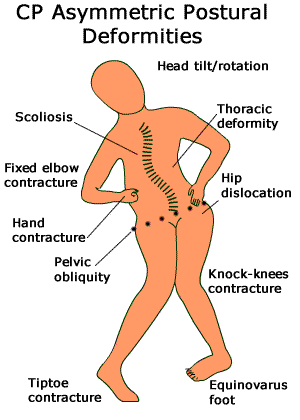 Spasticity is typically the major challenge in managing children with CP because it can cause difficulties with coordination, strength, and some areas of motor control.
Spasticity is typically the major challenge in managing children with CP because it can cause difficulties with coordination, strength, and some areas of motor control. Spasticity is typically the major challenge in managing children with CP because it can cause difficulties with coordination, strength, and some areas of motor control.
Spasticity is typically the major challenge in managing children with CP because it can cause difficulties with coordination, strength, and some areas of motor control.
While spasticity may affect any muscle group in the body, there are common patterns seen in children with cerebral palsy. Spasticity in the muscles of one or both legs may affect a person’s ability to:
Spasticity on the upper limbs (arms and hands) manifests as bent elbows, bent wrists, and/or fisted fingers.
 Effect on the lower limbs (legs)
Effect on the lower limbs (legs)
Spasticity on one or both of the legs can lead to hip flexion with leg lift, legs pulled together, and/or toes pointed downwards and inwards with the heel off the ground. Raised heel is due to calf muscle contracture.
Effect on speech
Spasticity can also be present in the tongue, facial muscles or vocal folds. Leading to the following:
https://cerebralpalsy.org.au/cerebral-palsy/types/spastic
Effect on upper body
The Manual Ability Classification System (MACS) classifies performance levels of the upper body that are affected by spasticity in children with CP.
Table 1 describes the levels in the MACS of how children with CP use their hands when handling objects in daily activities. Improvement in these levels can increase their independence in these activities (Shierk et al., 2016).
Manual Ability Classification System (MACS) |
|
Level I |
Handles objects easily and successfully |
Level II |
Handles most objects, but with somewhat reduced quality and/or speed of achievement |
Level III |
Handles objects with difficulty; needs help to prepare or modify activities |
Level IV |
Handles a limited selection of easily managed objects in adapted situations |
Level V |
Does not handle objects and has severely limited ability to perform even simple actions. (Eliasson et al., 2006) |
Using the MAC classification system as a guide, children are managed differently depending on their level of function.
MACS level 1 - good manual ability and overall independence with daily tasks.
MACS level II - typically independent with daily activities; can use alternative strategies to complete tasks; CIMT followed by bimanual training are therapeutic interventions for this level. MACS level III requires modifications of daily tasks to be successful. Multiple interventions with CIMT, bimanual, and goal-directed therapy are often used.
MACS level IV requires goal-directed therapy with less CIMT and bimanual training because of the lessoned ability to endure.
MACS level V patients have severely limited ability to perform simple manual tasks; management is typically with BoNT-A injections or therapy to improve hygiene, reduce pain, or ease caregiver care (Shierk et al., 2016).
General spasticity is typically the major challenge in managing CP children because of difficulties with coordination, strength, and some areas of motor control. The following treatment approaches are commonly used for spasticity:
• Physiotherapy
• Occupational therapy
• Botulinum toxin injections
• Selective dorsal rhizotomy
• Intrathecal baclofen (Upadhyay et al., 2020).
Some surgical procedures can be done, including lengthening of the adductors and hamstrings, multilevel surgery of the ankle and foot, nerve blocking, tendon transfers, and joint stabilization (Padmakar, 2019).
Medication used to treat spasticity
Baclofen – a skeletal muscle relaxant (antispasmodic agent) – side effects include possible allergic reactions, drowsiness, dizziness, weakness, and others (Padmakar et al., 2019).
Diazepam ( a benzodiazepine) – controls muscle spasms and spasticity – side effects include habit forming, increased drowsiness, tiredness, headache, muscle weakness, confusion, and others (Padmakar et al., 2019).
Clonazepam ( a Benzodiazepine) is used to treat seizures and anxiety – side effects include being addictive, causing drowsiness, dizziness, loss of coordination, and others. https://www.webmd.com/drugs/2/drug-14403-6006/clonazepam-oral/clonazepam-oral/details
Dantrolene – used to relax certain muscles and relieve spasms, cramping, and tightness of muscles – side effects include allergic reactions, enhancement of the effects of CNS depressants such as antihistamines, may cause drowsiness, dizziness or lightheadedness, vision problems, and others. https://www.mayoclinic.org/drugs-supplements/dantrolene-oral-route/description/drg-20063299.
Tizanidine (muscle relaxant) is a short acting muscle relaxant used to treat spasticity and muscle tightness – side effects include chest pain or discomfort, fever or chills, nausea or vomiting, unusual tiredness, and others. https://www.mayoclinic.org/drugs-supplements/tizanidine-oral-route/description/drg-20066921
Instant Feedback:
T or F Spasticity is a minor challenge in treating a child with Cerebral Palsy.
References
Eliasson, A.C., Krumlinde-Sundholm, L., Rösblad B, et al. (2006). The Manual Ability Classification System (MACS) for children with cerebral palsy: scale development and evidence of validity and reliability. Dev Med Child Neurol 48(7), 549–554.
Padmakar, S., Kumar, K.& Parveen, S. (2019). Management and treatment of cerebral palsy in children. Indian Journal Of Pharmacy practice. 10,194–199.
Shierk, A., Lake, A. & Haas, T. (2016). Review of Therapeutic Interventions for the Upper Limb Classified by Manual Ability in Children with Cerebral Palsy. Semin Plast Surg. 30(1), 14-23.
Upadhyay, J., Tiwari, N. & Ansari, M. N. (2020). Cerebral palsy: Aetiology, pathophysiology, and therapeutic interventions. Clinical and Experimental Pharmacology and Physiology. 47(12), 1891–1901.